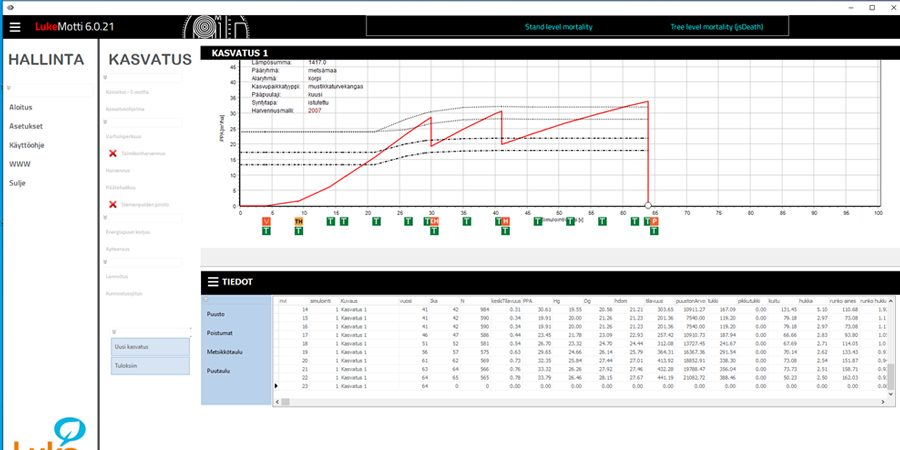MOTTI

A forest growth simulator to analyse the effects of management options on stand dynamics and ecosystem services' provision.

MOTTI is a forest growth model with tools to simulate stand development under different kind of management interventions (such as regeneration establishment, juvenile stand management, commercial thinning, final felling). It provides outputs in terms of forest structure, timber products, economic profitability, carbon stored, and biodiversity values (deadwood). It uses the stand as a simulation unit, and it can be scaled up at the regional or national level.
In OptFORESTS, we use MOTTI to co-develop innovative management scenarios with stakeholders, considering their desired outputs under the present challenge, such as climate change and a higher focus on environmental services. We will run a province-level analysis covering many different forested landscapes. The scenarios will reflect changing forestry objectives obtained by changing management interventions (including different uses of FRM).
Main model information
MOTTI has a user-friendly graphical interface, in finnish or in english, and a batch mode for intensive simulations. It can be used for:
- Exploration and assessment of management options
- Estimation of ecosystem services realised
- Teaching and training
Norway spruce, Scots pine, Silver and Pubescent birch, and other species
Rotation forestry with single- or multi-species stands, modules for Continuous Cover Forestry are being implemented
Hannu Salminen, LUKE (Rovaniemi, Finland)
hannu.salminen@luke.fi
Additional model description
- Distant independent tree growth models (height & diameter)
- Growth response to silvicultural interventions (mediated by live crown ratio)
- Mortality by competition (self-thinning), or by aging
- Use of improved FRM
- Stand description (temperature sum, site fertility class)
- Initial forest inventory (tree list, or average size and density)
- Management scenario
- Usual dendrometric variables describing stand composition and structure
- Timber products realised and their economic assessment
- Carbon storage
- Biodiversity value (from deadwood)
List of References
- Hynynen, J., Ojansuu, R., Hökkä, H., Siipilehto, J., Salminen, H., Haapala, P. (2002). Models for predicting stand development in MELA System, Research papers. Metsäntutkimuslaitos, Vantaa, Finland. http://urn.fi/URN:ISBN:951-40-1815-X
- Hynynen, J., Salminen, H., Ahtikoski, A., Huuskonen, S., Ojansuu, R., Siipilehto, J., Lehtonen, M., Rummukainen, A., Kojola, S., Eerikäinen, K. (2014). Scenario analysis for the biomass supply potential and the future development of Finnish forest resources (No. 302), Working Papers of the Finnish Forest Research Institute. Finnish Forest Research Institute, Vantaa, Finland. http://urn.fi/URN:ISBN:978-951-40-2487-0
- Hynynen, J., Salminen, H., Ahtikoski, A., Huuskonen, S., Ojansuu, R., Siipilehto, J., Lehtonen, M., Eerikäinen, K. (2015) Long-term impacts of forest management on biomass supply and forest resource development: a scenario analysis for Finland. Eur J Forest Res 134, 415–431. https://doi.org/10.1007/s10342-014-0860-0
- Serrano-León, H., Ahtikoski, A., Sonesson, J., Fady, B., Lindner, M., Meredieu, C., Raffin, A., Perret, S., Perot, T., Orazio, C. (2021). From genetic gain to economic gain: simulated growth and financial performance of genetically improved Pinus sylvestris and Pinus pinaster planted stands in France, Finland and Sweden. Forestry: An International Journal of Forest Research 94, 512–525. https://doi.org/10.1093/forestry/cpab004
